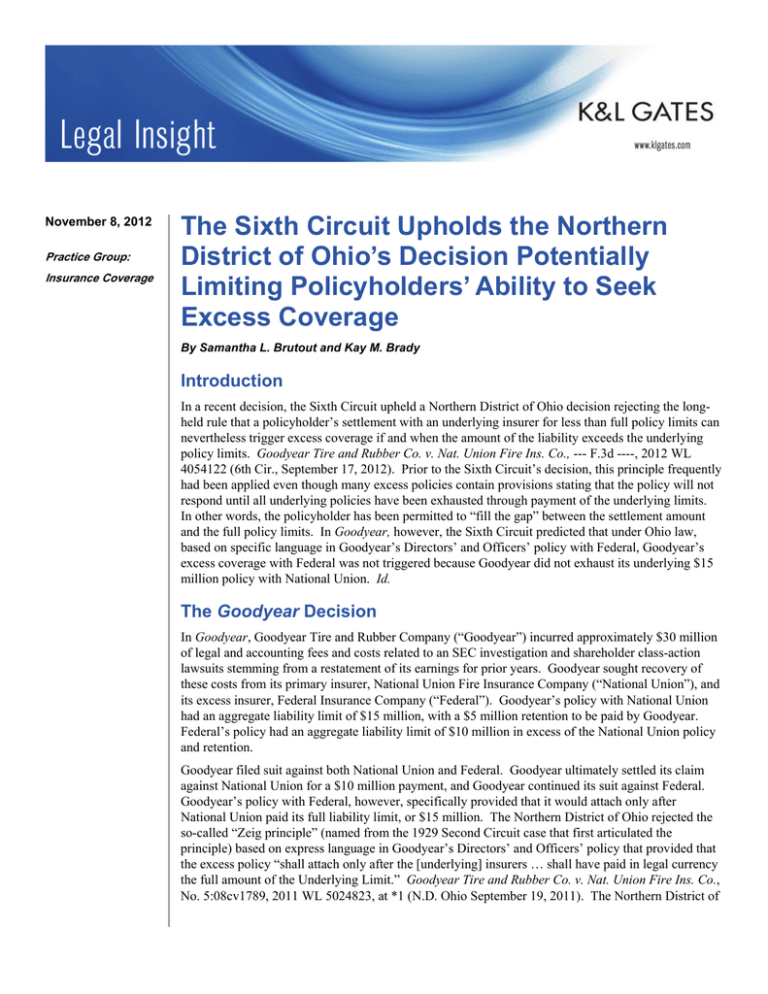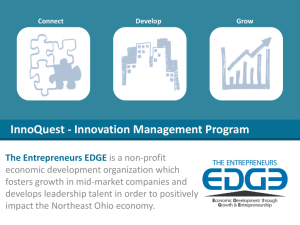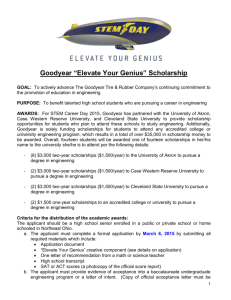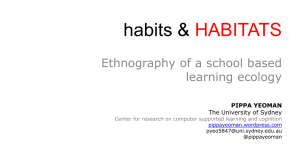The Sixth Circuit Upholds the Northern District of Ohio’s Decision Potentially
advertisement

November 8, 2012 Practice Group: Insurance Coverage The Sixth Circuit Upholds the Northern District of Ohio’s Decision Potentially Limiting Policyholders’ Ability to Seek Excess Coverage By Samantha L. Brutout and Kay M. Brady Introduction In a recent decision, the Sixth Circuit upheld a Northern District of Ohio decision rejecting the longheld rule that a policyholder’s settlement with an underlying insurer for less than full policy limits can nevertheless trigger excess coverage if and when the amount of the liability exceeds the underlying policy limits. Goodyear Tire and Rubber Co. v. Nat. Union Fire Ins. Co., --- F.3d ----, 2012 WL 4054122 (6th Cir., September 17, 2012). Prior to the Sixth Circuit’s decision, this principle frequently had been applied even though many excess policies contain provisions stating that the policy will not respond until all underlying policies have been exhausted through payment of the underlying limits. In other words, the policyholder has been permitted to “fill the gap” between the settlement amount and the full policy limits. In Goodyear, however, the Sixth Circuit predicted that under Ohio law, based on specific language in Goodyear’s Directors’ and Officers’ policy with Federal, Goodyear’s excess coverage with Federal was not triggered because Goodyear did not exhaust its underlying $15 million policy with National Union. Id. The Goodyear Decision In Goodyear, Goodyear Tire and Rubber Company (“Goodyear”) incurred approximately $30 million of legal and accounting fees and costs related to an SEC investigation and shareholder class-action lawsuits stemming from a restatement of its earnings for prior years. Goodyear sought recovery of these costs from its primary insurer, National Union Fire Insurance Company (“National Union”), and its excess insurer, Federal Insurance Company (“Federal”). Goodyear’s policy with National Union had an aggregate liability limit of $15 million, with a $5 million retention to be paid by Goodyear. Federal’s policy had an aggregate liability limit of $10 million in excess of the National Union policy and retention. Goodyear filed suit against both National Union and Federal. Goodyear ultimately settled its claim against National Union for a $10 million payment, and Goodyear continued its suit against Federal. Goodyear’s policy with Federal, however, specifically provided that it would attach only after National Union paid its full liability limit, or $15 million. The Northern District of Ohio rejected the so-called “Zeig principle” (named from the 1929 Second Circuit case that first articulated the principle) based on express language in Goodyear’s Directors’ and Officers’ policy that provided that the excess policy “shall attach only after the [underlying] insurers … shall have paid in legal currency the full amount of the Underlying Limit.” Goodyear Tire and Rubber Co. v. Nat. Union Fire Ins. Co., No. 5:08cv1789, 2011 WL 5024823, at *1 (N.D. Ohio September 19, 2011). The Northern District of The Sixth Circuit Upholds the Northern District of Ohio’s Decision Potentially Limiting Policyholders’ Ability to Seek Excess Coverage Ohio recognized the public policy interests in promoting settlements, but refused “to find Federal’s contract provision unenforceable.” Id. at *3. On appeal, Goodyear argued: (1) that the Sixth Circuit should enforce Ohio’s public policy favoring settlements rather than the terms of the insurance contract; and (2) the Court should disregard the exhaustion provision because Federal was not prejudiced in any way by the less-than-limits settlement. Goodyear, 2012 WL 4054122, at *2 (internal citations omitted). The Sixth Circuit rejected both arguments and affirmed the Northern District of Ohio’s decision to deny coverage. With respect to its public policy argument, Goodyear cited two underinsured-motorist cases, which the Court determined were inapplicable to Goodyear: But this is hardly an underinsured-motorist case. Underinsured-motorist coverage was mandated under Ohio law at the time of the accidents in Bogan and Fulmer, see Ohio R.C. § 3937.18(A)(2); and the court in Bogan held that the exhaustion provision there was contrary to ‘the intent of the General Assembly as expressed in’ in the statute mandating such coverage, 521 N.E.2d at 453. We do not have any such conflict with legislative intent here, which is reason enough not to apply Bogan or Fulmer. The court similarly rejected Goodyear’s prejudice argument: But this case does not concern a mere notice or cooperation requirement, which perhaps we could wave off absent any real harm to the insurer. Rather, the provision at issue here is where the rubber hits the road: the agreement’s Insuring Clause, under whose terms Federal undisputedly did not agree to provide the coverage that Goodyear now seeks. Conclusion Although Goodyear is simply a prediction of a single state’s law based on the specific policy language at issue, it nonetheless is a negative decision for policyholders. Other courts, however, have still found in favor of policyholders when the language of the policy favors the policyholder or is ambiguous. See Maximus, Inc. v. Twin City Fire Ins. Co., 856 F.Supp.2d. 797, 804 (E.D. Va. 2012). In Maximus, the court found that “Axis Policy’s exhaustion provision is ambiguous in that it does not clearly require all underlying insurance carriers themselves to pay the full amounts of their policy limits in order to trigger the Axis Policy’s coverage and does not clearly provide that settling for less than the policy limit, even if the insured fills the gap, fails to satisfy the exhaustion requirement.” Id. The applicable insurance provision stated: The insurance afforded under this Policy shall apply only after all applicable Underlying Insurance with respect to an Insurance Product has been exhausted by actual payment under such Underlying Insurance, and shall only pay excess of any retention or deductible amounts provided in the Primary Policy and other exhausted Underlying Insurance. As Goodyear and Maximus illustrate, there is an ongoing debate, and the policy’s language, and even subtle differences in wording, can be determinative. Policyholders should be mindful of the language in their own policies before settling with their insurers for less than full limits of liability, and seek to structure their settlements appropriately. Policyholders should also consider obtaining, if possible, “shaving of limits” wording in excess policies that may avoid the exhaustion argument adopted in Goodyear. 2 The Sixth Circuit Upholds the Northern District of Ohio’s Decision Potentially Limiting Policyholders’ Ability to Seek Excess Coverage Authors: Samantha L. Brutout samantha.brutout@klgates.com +1.412.355.6255 Kay M. Brady kay.brady@klgates.com +1.412.355.6235 3



